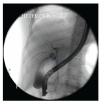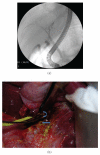Aberrant right hepatic duct draining into the cystic duct: clinical outcomes and management
- PMID: 21687615
- PMCID: PMC3113254
- DOI: 10.1155/2011/458915
Aberrant right hepatic duct draining into the cystic duct: clinical outcomes and management
Abstract
Background. Aberrant right hepatic duct (ARHD) draining into cystic duct (CD) is relatively rare but clinically important because of its susceptibility to injuries during cholecystectomy. These injuries are often-times missed or diagnosed late and as a result can develop serious complications. Methods. Four consecutive patients diagnosed with ARHD draining into CD were identified for inclusion. Results. The mean age of patients was 42.5 years. The diagnosis in one of the patient was incidental during a routine endoscopic retrograde cholangiopancreatography (ERCP). Other three patients were diagnosed post-cholecystectomy- one presented with suspected intra-operative biliary injury, one with persistent bile leak and another with recurrent cholangitis. Inadequate filling of the segment of liver on ERCP with dilation of intrahepatic ducts in the corresponding segment on imaging was present in two patients with complete obstruction of ARHD which was managed surgically. In another patient, the partially obstructed ARHD was managed by endoscopic therapy. Conclusion. ARHD draining into the CD can have varied clinical manifestations. In appropriate clinical settings, it should be suspected in patients with persistence of bile leak early after cholecystectomy, segmental dilation of intrahepatic-bile ducts on imaging and paucity of intrahepatic filling in a segment of liver on ERCP.
Figures




Similar articles
-
The role of ERCP in patients after laparoscopic cholecystectomy.Am J Gastroenterol. 1994 Sep;89(9):1523-7. Am J Gastroenterol. 1994. PMID: 8079931
-
Endoscopic management of bile leaks after laparoscopic cholecystectomy.S Afr J Surg. 2013 Oct 25;51(4):116-21. doi: 10.7196/sajs.1829. S Afr J Surg. 2013. PMID: 24209694
-
Long-term outcomes of endoscopic treatment of aberrant hepatic duct injuries after cholecystectomy.Gastrointest Endosc. 2020 Mar;91(3):584-592. doi: 10.1016/j.gie.2019.09.043. Epub 2019 Oct 17. Gastrointest Endosc. 2020. PMID: 31629720
-
Bile leaks after videolaparoscopic cholecystectomy: duct of Luschka. Endoscopic treatment in a single centre and brief literature review on current management.Ann Ital Chir. 2012 Jul-Aug;83(4):303-12. Ann Ital Chir. 2012. PMID: 23012722 Review.
-
Endoscopic retrograde cholangiopancreatography and laparoscopic cholecystectomy.Dig Dis. 1996 Nov-Dec;14(6):371-81. doi: 10.1159/000171571. Dig Dis. 1996. PMID: 9030469 Review.
Cited by
-
Risk of Gallstone Formation in Aberrant Extrahepatic Biliary Tract Anatomy: A Review of Literature.Cureus. 2020 Aug 25;12(8):e10009. doi: 10.7759/cureus.10009. Cureus. 2020. PMID: 32864277 Free PMC article. Review.
-
Clinical implications of aberrant anatomy of the common hepatic duct in liver surgery: a systematic review and meta-analysis.Surg Radiol Anat. 2024 Dec;46(12):2027-2047. doi: 10.1007/s00276-024-03494-8. Epub 2024 Sep 27. Surg Radiol Anat. 2024. PMID: 39333309
-
Laparoscopic cholecystectomy with aberrant bile duct detected by intraoperative fluorescent cholangiography concomitant with angiography: A case report.Int J Surg Case Rep. 2018;51:14-16. doi: 10.1016/j.ijscr.2018.08.009. Epub 2018 Aug 13. Int J Surg Case Rep. 2018. PMID: 30130667 Free PMC article.
-
Successful management of aberrant right hepatic duct during laparoscopic cholecystectomy: a rare case report.Surg Case Rep. 2019 May 9;5(1):74. doi: 10.1186/s40792-019-0632-7. Surg Case Rep. 2019. PMID: 31073708 Free PMC article.
-
A survey of the accuracy of interpretation of intraoperative cholangiograms.HPB (Oxford). 2012 Oct;14(10):673-6. doi: 10.1111/j.1477-2574.2012.00501.x. Epub 2012 Jun 11. HPB (Oxford). 2012. PMID: 22954003 Free PMC article.
References
-
- Strasberg SM, Hertl M, Soper NJ. An analysis of the problem of biliary injury during laparoscopic cholecystectomy. Journal of the American College of Surgeons. 1995;180(1):101–125. - PubMed
-
- Richardson MC, Bell G, Fullarton GM. Incidence and nature of bile duct injuries following laparoscopic cholecystectomy: an audit of 5913 cases. British Journal of Surgery. 1996;83(10):1356–1360. - PubMed
-
- Krähenbühl L, Sclabas G, Wente MN, Schäfer M, Schlumpf R, Büchler MW. Incidence, risk factors, and prevention of biliary tract injuries during laparoscopic cholecystectomy in Switzerland. World Journal of Surgery. 2001;25(10):1325–1330. - PubMed
-
- Khan MH, Howard TJ, Fogel EL, et al. Frequency of biliary complications after laparoscopic cholecystectomy detected by ERCP: experience at a large tertiary referral center. Gastrointestinal Endoscopy. 2007;65(2):247–252. - PubMed
-
- Martin RF, Rossi RL, Traverso LW. Bile duct injuries: spectrum, mechanisms of injury, and their prevention. Surgical Clinics of North America. 1994;74(4):781–807. - PubMed
LinkOut - more resources
Full Text Sources

